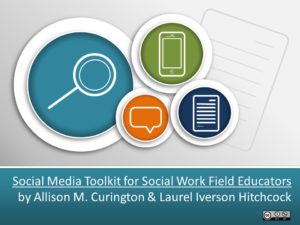Modeling Social Justice through Innovative, Low-Cost Textbook Options for Social Work Students
Both Dr. Victoria Venable and Dr. Becky Anthony (@becky_anthony) and are assistant professors in the Department of Social Work at Salisbury University. In this blog post, they write about designing and self-publishing a course workbook for a generalist level basic interviewing skills practice course. They also share results from a pilot evaluation the workbook and supplemental materials.
The cost of textbooks is problematic for many students at American colleges and universities. College textbook prices have increased by 82% from 2003 to 2013 (Bureau of Labor Statistics, 2014). This economic injustice causes students to miss out on educational opportunities because they have to prioritize paying for their basic needs over textbooks. According to a 2014 study, over 65% of students reported they did not buy a textbook because the cost was too high (Student PIRGs, 2014). If students are not purchasing the book, they cannot read for class – this revelation caused us to brainstorm creative ways to engage students by lowering the cost of textbooks, in hopes of increasing their reading. As social workers, the NASW Code of Ethics asks us to challenge social injustices. We viewed the price of textbooks as a social injustice and explored options that would allow our students to better participate in their learning experience.
Using Technology for Life-Long Learning in Social Work: Professional Learning Networks
This post was written and edited by Nancy J. Smyth, Melanie Sage, and myself as part of our collaboration on our forthcoming book, Teaching Social Work with Digital Technology, to be published by CSWE Press in 2018.
Professional Learning Networks (PLN) exist when social workers use social media to collect information related to professional interests, share this information with others, and collaborate with others on projects (Richardson & Mancebelli, 2011). For more details about PLN, please see this blog post titled Personal Learning Networks for Social Workers (Hitchcock, 2015). A PLN is unique to each person, and learning how others structure their PLN can be helpful in setting up your own network. In this blog post, we asked two social work educators to share their best tips for using technology as a tool for learning.
Kelly Joplin, an Assistant Professor and Director of Field Education from the Carver School of Social Work at Campbellsville University, uses a productivity app called Evernote to support her personal learning network (PLN). She writes:
I love Evernote! It keeps me organized. It has folders where I collect articles, videos, audio clips, pdfs, maps, and links to resources for each of my classes. I use many different types of media in my classes and this makes pulling those different pieces onto the classroom screen seamless. I do not have to toggle back and forth between apps or the internet therefore eliminating the uncomfortable classroom lag time while bringing up media. (I find I lose students in the lag.)
Social Media Toolkit for Social Work Field Educators – Get your Free Copy!
 We are pleased to announce the availability of the Social Media Toolkit for Social Work Field Educators. This toolkit provides Field and other Social Work Educators with tools and resources to help social work students and field instructors assess, develop, and maintain an online identity for professional purposes. There are two parts to the toolkit – an Educator’s Guide and a PowerPoint Slide Deck. The Educator’s Guide provides directions, descriptions, and handouts related to the content of the toolkit while the Slide Deck includes pre-formatted slides with selected content for presenting n the classroom or a workshop. Content in this toolkit can be easily adapted to agency-level continuing education.
We are pleased to announce the availability of the Social Media Toolkit for Social Work Field Educators. This toolkit provides Field and other Social Work Educators with tools and resources to help social work students and field instructors assess, develop, and maintain an online identity for professional purposes. There are two parts to the toolkit – an Educator’s Guide and a PowerPoint Slide Deck. The Educator’s Guide provides directions, descriptions, and handouts related to the content of the toolkit while the Slide Deck includes pre-formatted slides with selected content for presenting n the classroom or a workshop. Content in this toolkit can be easily adapted to agency-level continuing education.
The content of this toolkit is divided into five different topics centered on how to use social media professionally as a social worker:
– Reflecting on Social Media Use in Social Work Practice
– Engaging and Self-Assessment with Social Media
– Professional Practice with Social Media
– Case Studies for Students & Field Educators
– Social Media Learning Activities for Field Education
Teaching Technology-Mediated Practice in a Clinical MSW Program
 Janet Vizina-Roubal, DSW, MSW, is an Associate Professor of Social Work at Ferris State University in the Department of Social Work. In this blog post, she writes about her inspiration for a technology-mediated practice assignment with MSW students. Assignments like this one will be increasingly valuable for social work students preparing to use technology with clients while meeting professional and ethical practice standards such as the NASW Code of Ethics and the NASW, ABSW, CSWE & ACSW Standards for Technology in Social Work Practice. If you have questions about the assignment, you can reach Dr. Vizina-Roubal on Twitter at @jvizina.
Janet Vizina-Roubal, DSW, MSW, is an Associate Professor of Social Work at Ferris State University in the Department of Social Work. In this blog post, she writes about her inspiration for a technology-mediated practice assignment with MSW students. Assignments like this one will be increasingly valuable for social work students preparing to use technology with clients while meeting professional and ethical practice standards such as the NASW Code of Ethics and the NASW, ABSW, CSWE & ACSW Standards for Technology in Social Work Practice. If you have questions about the assignment, you can reach Dr. Vizina-Roubal on Twitter at @jvizina.
I started teaching my first clinical MSW course the fall of 2014 with excitement and nervousness. With almost eight years of clinical experience in school social work and outpatient therapy, I had a great toolbox of practice tips to share with my students. Adding to the excitement was the idea of creating a technology-based assignment where students could learn and practice technology-enhanced therapy skills. Because I had completed and presented research with a colleague about the benefits of using iPhones in child welfare work, I was curious about how I could create a technology-based assignment for MSW social work students.
Clinical MSW social work classes typically rely on a vast amount of face-to-face role-plays, requiring students to play the part of client and social worker. This experiential learning is challenging, however is very effective at teaching students critical clinical skills. I was interested in stretching this experiential learning process into role-plays for a technology-mediated learning environment, with the goal of helping students learn how to engage with clients via technology-based communication tools. Based on this idea, I worked to structure assignments that would allow students to learn how to use technology within clinical social work. As I embarked on this journey, I searched for curricula or assignments on how to teach online therapy along with best practices. Bewildered, I found almost nothing (Cardenas, Serrano, Flores, & De 2008). I did stumble upon research that showed promising findings that online therapy might be as effective as face-to-face therapy (Chester & Glass, 2006; Dowling & Rickwood, 2013; Holmes & Foster, 2012). This finding legitimized my interest in pursuing this course of instruction and compelled me to develop assignments where students gained experience within online therapy; practicing as the client as well as the therapist.




